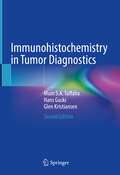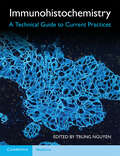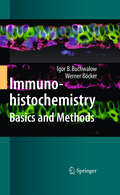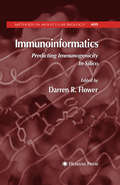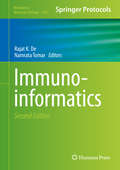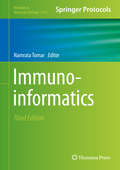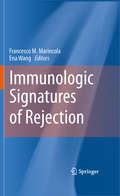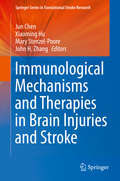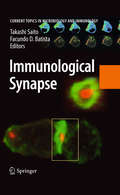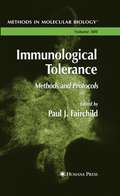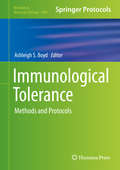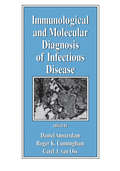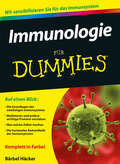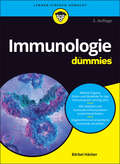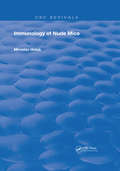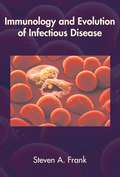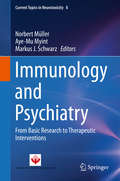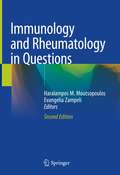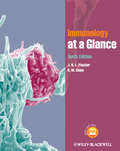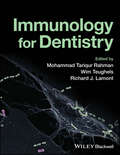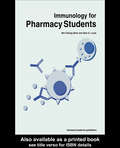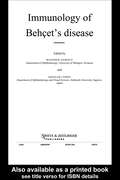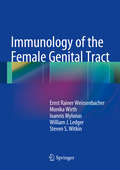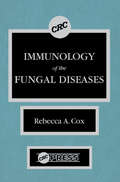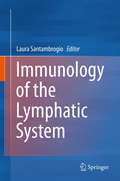- Table View
- List View
Immunohistochemistry in Tumor Diagnostics
by Hans Guski Glen Kristiansen Muin S.A. TuffahaThis new and updated edition provides an extensive overview of the antibodies employed in diagnostic tumor histopathology, and it presents concise summaries of the immunoprofiles of most tumors. Additionally, it offers practical diagnostic algorithms and invaluable tips to facilitate the interpretation of results.The work includes the newest available antibodies and the most recent 5th edition of the WHO classification of tumors. Furthermore, a chapter on biomarkers for theranostic applications has been added to enhance the book's utility. Designed as a practical and user-friendly bench reference for diagnostic tumor histopathology, this book is recommended to histopathologists of all levels, from aspiring residents to seasoned specialists seeking a reliable and comprehensive resource for tumor diagnostics. Moreover, it is highly recommended for oncologists, hematologists, and researchers involved in these fields.
Immunohistochemistry: A Technical Guide to Current Practices
by Trung NguyenThis book will enable practitioners to understand the many complex intricacies of immunohistochemistry (IHC) and make best use of this powerful analytical tool. Providing a thorough grounding in the fundamentals of immunohistochemistry, the book includes several chapters on robotics and automation technology, giving key information on the design of machines and tips to maximise workflow efficiencies. The relationship between IHC and molecular pathology is explained clearly, demonstrating the increasing impact on personalized medicine and targeted therapies for cancer patients. The staining protocol is deconstructed, allowing the reader to adapt it for a variety of diagnostic and research applications. Written by experts at the forefront of hospital immunohistochemistry, there is a strong emphasis on practical guidance on a range of techniques as well as troubleshooting of common problems driven by the authors' experiences. Extensively illustrated with high-quality colour images, this is an invaluable resource to all pathology practitioners utilising the technique.
Immunohistochemistry: Basics and Methods
by Igor B. Buchwalow Werner BöckerWhile many excellent texts and monographs exist which cover various aspects of immunohistochemistry, the lack of a concise comprehensive guide to using the field's methods was a major motivation for the authors to write this book. The authors carefully selected the methods and easy-to-adopt protocols discussed. In addition to estabished techniques, special attention was paid to current developments in immunohistochemistry such as antigen retrieval, signal amplification, the use of epitope tags, multiple immunolabeling, and diagnostic immunohistochemistry. All procedures examined have been tested by the authors; many are routinely used in daily practice in their institute. Each chapter starts with a short introduction to the respective method's underlying principles before presenting step-by-step protocols and instructions, including precise recipes for all materials needed. Thus, the book is suitable for a broad audience, ranging from students and technical assistants to experienced researchers.
Immunoinformatics
by Darren R. FlowerThis volume both engages the reader and provides a sound foundation for the use of immunoinformatics techniques in immunology and vaccinology. It addresses databases, HLA supertypes, MCH binding, and other properties of immune systems. The book contains chapters written by leaders in the field and provides a firm background for anyone working in immunoinformatics in one easy-to-use, insightful volume.
Immunoinformatics
by Rajat K. De Namrata TomarAt the intersection of experimental and computational sciences, the second edition of Immunoinformatics provides biological insights as well as a simpler way to implement approaches and algorithms in the immunoinformatics research domain. After an introductory section, this extensive volume moves on to cover topics such as databases, tools for prediction, systems biology approaches, as well as a variety of immunoinformatics applications. As part of the highly successful Methods in Molecular Biology series, chapters include the type of detailed information and implementation advice to ensure successful results. Comprehensive and practical, Immunoinformatics, Second Edition aims at students and researchers from diverse backgrounds and levels interested in working with immunological problems.
Immunoinformatics (Methods in Molecular Biology #2131)
by Namrata TomarThis book covers a wide range of diverse immunoinformatics research topics, involving tools and databases of potential epitope prediction, HLA gene analysis, MHC characterizing, in silico vaccine design, mathematical modeling of host-pathogen interactions, and network analysis of immune system data. In that way, this fully updated volume explores the enormous value of computational tools and models in immunology research. Written for the highly successful Methods in Molecular Biology series, chapters include the kind of key insights and detailed implementation advice to encourage successful results in the lab. Authoritative and practical, Immunoinformatics, Third Edition serves as an ideal guide for scientists working at the intersection of bioinformatics, mathematical modelling, and statistics for the study of immune systems biology.
Immunologic Signatures of Rejection
by Francesco M. Marincola Ena WangThis book discusses the mechanisms leading to immune-mediated tissue rejection following the hypothesis that independent of the disease process the final effector mechanism is shared by most (but not all) pathologies and it is relatively simple. The book covers evidence gathered to support the thesis by studies performed in humans during rejection or in experimental models and will focus particularly (but not exclusively) on the analysis of the rejected tissue rather than the systemic circulation. Several disease processes are discussed including example of chronic inflammatory process without resolution of the pathologic process and acute one with resolution of the pathologic process (clearance of pathogen, rejection of tumor) or unwanted tissue destruction (allograft rejection, autoimmunity).
Immunological Mechanisms and Therapies in Brain Injuries and Stroke
by John H. Zhang Jun Chen Xiaoming Hu Mary Stenzel-PooreRecent research has revealed the importance of immunological mechanisms and inflammation in delaying damage and/or promoting repair after an acute injury to the central nervous system. This book provides a comprehensive and up-to-date overview of the role of immunological mechanisms and therapies for treating acute neurological injuries such as cerebral ischemia, hemorrhage, and brain and spinal cord trauma. In several sections, the contributing authors provide a review of immunological mechanisms involved in neurological injury and of various translational and clinical research aimed at harnessing those mechanisms for better patient outcomes.
Immunological Synapse
by Takashi Saito Facundo D. BatistaWhile the importance of the immune synapse as a dynamic cell junction that regulates intercellular communication and viral transmission is universally recognized, many of quantitative and qualitative details remain unsettled. The plasticity of this cell junction has to accommodate many very different binding partners and control the fate of interacting cells. It is likely that developmental changes in the state of the T cells or the APCs can impact the structure of the synapse. It is hoped that uncovering the ordered molecular rearrangement at the membrane will provide the long sought after clues for the remarkable functional sensitivity of T lymphocytes. These dynamic molecular interactions may eventually explain how engagement of the same TCR can generate different outcomes that resolve the immune challenges. The reviews in this issue present a broad slice of the many diverse topics that are currently intensely debated.
Immunological Tolerance
by Paul J. FairchildImmunological Tolerance: Methods and Protocols is a comprehensive guide to the techniques currently used for culturing and characterising the cell types responsible for imposing self-tolerance and the experimental models employed to study their function both in vitro and in vivo. This guide is aimed at AIDS researchers, immunologists, transplant surgeons/specialists, and biotechnologists.
Immunological Tolerance: Methods and Protocols (Methods in Molecular Biology #1899)
by Ashleigh S. BoydThis edition provides a detailed, up-to-date overview of methods used in the field of immune tolerance. Chapters guide readers through tolerogenic cell types, isolating tolerogenic cell populations for study and therapeutic utility, multiple methods to study the mechanisms underpinning tolerance, methods to induce tolerance through thymus progenitors, and methods to assess the breakdown of immune tolerance in specific pathological conditions. Written in the highly successful Methods in Molecular Biology series format, chapters include introductions to their respective topics, lists of the necessary materials and reagents, step-by-step, readily reproducible laboratory protocols, and tips on troubleshooting and avoiding known pitfalls. Authoritative and cutting-edge, Immunological Tolerance: Methods and Protocols aims to ensure successful results in the further study of this vital field.
Immunological and Molecular Diagnosis of Infectious Disease
by Carel J. van OssWritten by world-renowned experts, this book addresses immunological and molecular methodologies of diagnosis as well as clinical aspects of diseases. It book discusses DNA and RNA amplification methods, explains ELISA approaches, and introduces rapid diagnosis techniques, biosensors, and flow cytometry. The book examines bacterial and parasitic in
Immunologie fur Dummies (Für Dummies)
by Bärbel HäckerVom Antigen bis zur Zyto - toxizität – alles, was Sie über Immunologie wissen müssen Unser Immunsystem ist komplex – zum Glück für uns als Menschen, aber auch zum Leidwesen der Studenten, die sich mit Immunologie beschäftigen. Bärbel Häcker hilft Ihnen, sich dieser Materie zu nähern. Leicht verständlich erklärt sie die Komponenten des Immunsystems sowie die zelluläre und die humorale Immunantwort. Sie erläu - tert, was Sie über die Mediatoren und die anderen Proteine im Immunsystem wissen sollten und vieles mehr. Dieses Buch ist ein Wegweiser für jeden, der sich in dem Labyrinth aus Makrophagen, Lymphozyten und Granulo - zyten zurechtfinden muss. So können Sie der nächsten Klausur entspannt entgegensehen.
Immunologie für Dummies (Für Dummies)
by Bärbel HäckerUnser Immunsystem ist vielschichtig. Das ist gut für unsere Gesundheit, macht es Studierenden aber schwer, Immunologie zu lernen. Bärbel Häcker hilft Ihnen, sich der Materie zu nähern. Leicht verständlich erklärt sie die Komponenten des Immunsystems sowie die zelluläre und die humorale Immunantwort. Sie erläutert, was Sie über die Mediatoren und die anderen Proteine im Immunsystem wissen sollten und vieles mehr. So ist dieses Buch ein Wegweiser für jeden, der sich in dem Labyrinth aus Makrophagen, Lymphozyten und Granulozyten zurechtfinden muss. So begleitet, können Sie der nächsten Klausur entspannt entgegensehen.
Immunology Of Nude Mice (Routledge Revivals)
by Miroslav HolubFirst published in 1989, Immunology of Nude Mice presents a discussion of the nature of this viable laboratory mutant. This new volume updates all immunological information contained in the sparse literature concerning nude mice. It comprehensively explores some of the fre-quent questions associated with nude mice, such as if the mutant is really athymic or if the thymic defect causes all of the other deviations from brain to gonads. The practical consequences of hairlessness of the mutant are also consid-ered. Illustrated with original photographs and tables doc-umenting novel facts in immunology and physiology of nude mice, this publication is valuable for investigators and stu-dents entering the field.
Immunology and Evolution of Infectious Disease
by Steven A. FrankFrom HIV to influenza, the battle between infectious agents and the immune system is at the heart of disease. Knowledge of how and why parasites vary to escape recognition by the immune system is central to vaccine design, the control of epidemics, and our fundamental understanding of parasite ecology and evolution. As the first comprehensive synthesis of parasite variation at the molecular, population, and evolutionary levels, this book is essential reading for students and researchers throughout biology and biomedicine.The author uses an evolutionary perspective to meld the terms and findings of molecular biology, immunology, pathogen biology, and population dynamics. This multidisciplinary approach offers newcomers a readable introduction while giving specialists an invaluable guide to allied subjects. Every aspect of the immune response is presented in the functional context of parasite recognition and defense--an emphasis that gives structure to a tremendous amount of data and brings into sharp focus the great complexity of immunology. The problems that end each chapter set the challenge for future research, and the text includes extensive discussion of HIV, influenza, foot-and-mouth disease, and many other pathogens.This is the only book that treats in an integrated way all factors affecting variation in infectious disease. It is a superb teaching tool and a rich source of ideas for new and experienced researchers. For molecular biologists, immunologists, and evolutionary biologists, this book provides new insight into infectious agents, immunity, and the evolution of infectious disease.
Immunology and Psychiatry
by Norbert Müller Aye-Mu Myint Markus J. SchwarzPsychiatric disorders are one of the most dramatic burdens for humankind. The role of immune dysfunction in the pathophysiology of these disorders has emerged during the last years, because there has been tremendous progress in psychoneuroimmunological research. Many results are presented here by pioneers in the field. The book addresses various effects of the immune system on the pathophysiology and course of psychiatric disorders and highlights the possible future impact on treatment decisions of various psychiatric disorders, including schizophrenia and depression. The contributions cover the role of in utero immune challenges on the development of schizophrenia, the role of infections, and autoimmune diseases and mild immune activation in the development of depression and schizophrenia, the influence of immune responses in other disorders such as Tourette's, Alzheimer's, and OCD, the connections between mental and physical pain as well as between anti-inflammatory and antipsychotic drugs.
Immunology and Rheumatology in Questions
by Haralampos M. Moutsopoulos Evangelia ZampeliImmunology and Rheumatology in Questions, 2nd Edition addresses through short and concise questions-and-answers (Q&As) on one hand all major aspects of basic clinical and laboratory immunology necessary for understanding underlying immunological mechanisms of autoimmune rheumatic diseases. The majority however of Q&As in this book presents in a laconic way definitions, pathogenetic aspects, clinical and laboratory manifestations, differential diagnosis and the management of all categories of rheumatic diseases including systemic autoimmune, autoinflammatory, metabolic and degenerative. Furthermore, in separate sections of this manual Q&As addressing rheumatic manifestations from other organ systems are included. Finally, a chapter is devoted to treatment of rheumatic diseases analyzing indications and side-effects of different therapeutic modalities with illustrations and diagrams utilized throughout the book to present the information in a clear and schematic way. In this fully revised second edition, more than 120 new Q&As have been added and the answers to more than 90 Q&As has been modified after having critically incorporated all new knowledge generated in the past three years in the field of rheumatology, in an effort to bridge classical and current evidence-based knowledge and to present didactic and credible information. This book is valuable to test and acquire knowledge not only for rheumatologists but for every specialist in internal medicine, family practice, physical/rehabilitation medicine and orthopedic surgery.
Immunology at a Glance
by J.H.L. Playfair B. M. ChainImmunology at a Glance provides a user-friendly overview of the body's defence mechanisms. Ideal from day one of a medical, biomedical or life science course, the text begins with a basic overview of both adaptive and innate immunity, before progressing to applied immunological concepts, which look at what happens when things go wrong, and how, in clinical medicine, each body system can be affected by immunity. Each double-page spread corresponds to a typical lecture and diagrammatically summarises core concepts in immunology, through accessible schematic diagrams on left-hand pages, with key points concisely summarised on the right-hand page. There are also self-assessment essay questions so you can test your knowledge. New for this 10th edition: Thoroughly updated and reorganised chapters offer greater clarity and easier understanding for those new to the subject New chapters on cytokine receptors and 'Immunology in the Laboratory' A completely re-written section on autoimmunity A brand new companion website featuring self-assessment questions and PowerPoint slides of images from the book, ideal for teaching and revision at www. ataglanceseries. com/immunology Immunology at a Glance is the ideal companion for anyone about to start a new course in immunology and will appeal to medical and biomedical science students. Perfect for exam preparation, it provides the concepts and frameworks you need to succeed in your exam.
Immunology for Dentistry
by Richard J. Lamont Mohammad Tariqur Rahman Wim TeughelsImmunology for Dentistry Understand the fundamentals of oral immunology with this accessible reference Immunology for Dentistry fulfils the need for a comprehensive overview of oral immunology and its key aspects for dental medicine. Its broad-based and accessible coverage introduces readers to all essential elements of oral immunology, from mechanisms of the immune system through to specific diseases and pathogens and their interactions with the immune system. This thorough text will provide an understanding of the link between the oral immune system and oral microbiome as contributors to oral health. Readers will also find: A thorough introduction to the basic principles of immunology and immune response Detailed coverage of subjects including stem cell immunology, periodontitis, hormone modulation in periodontal inflammation and more Color diagrams demonstrating key concepts Authored by a team of international experts, Immunology for Dentistry provides a valuable approach to the fundamental and clinical aspects of immunology. It is a useful reference for dental students, teachers, and researchers, and will also be of interest to practicing dentists and specialists.
Immunology for Pharmacy Students
by Wei-Chiang Shen Stan G. LouieResponding to the clear need for an immunology text written with the pharmacist and pharmaceutical scientist in mind, this volume highlights issues of particular relevance to pharmacy practice, including hypersensitivity reactions to natural allergens and pharmaceutical agents. Core immunological issues, such as congenital immunodeficiency disorder
Immunology of Behçet's Disease
by Manfred Zierhut Shigeaki OhnoBeh's Disease (BD) is one of the most-studied systemic disorders characterized by an occlusive vasculopathy of multiple organs. The etiology and pathogenesis of BD are still unclear, but there is evidence for genetic, immunologic and infectious factors in the onset and throughout the course of the disease. This book summarizes our knowledge regarding the most important factors that induce or trigger BD. After an epidemiological overview, the clinical presentation of ocular and non-ocular symptoms of BD is summarized. The immunopathological changes reflect a chronic vasculitis of arterioles, venules, and capillaries. The book covers the role of T-cells, NK-T-cells, secreted cytokines, and neutrophils as well as immune reactions against various microbial heat shock proteins. It shows that the pathogenic gene involved in the development of BD is pinpointed to HLA-B51. It also discusses the treatment of BD, including anti-TNF-alpha-antibodies and interferon-alpha.
Immunology of the Female Genital Tract
by Ernst Rainer Weissenbacher Monika Wirth Ioannis Mylonas Klinik Für Geburtshilfe William J. Ledger Steven S. WitkinThis book systematically reviews and discusses recent studies and articles on the immunology of female genital tract tissue. The scope is broad, encompassing innate immune responses, adaptive (humoral and cell-mediated) immunity, the immunology of menstruation, the immunology of viral and bacterial infections, the immunology of normal and abnormal pregnancy, and immunological infertility. Throughout, tables and illustrations are judiciously used to facilitate understanding. Immunology of the Female Genital Tract will serve as an invaluable source of up-to-date information for all with an interest in this subject.
Immunology of the Fungal Diseases
by Rebecca A. CoxThis informative text is divided into eight chapters, each of which presents a comprehensive review of natural and acquired host defense mechanisms in a major mycotic disease. The chapters are written by distinguished scientists whose studies have contributed significantly to the understanding of the immunology of the mycoses. This text should provide a valuable reference for researchers, practicing clinicians, and new investigators entering this expanding field.
Immunology of the Lymphatic System
by Laura SantambrogioThis book will be a comprehensive study of the lymphatic system and its immunological role. It will begin with lymphatic capillaries, their origin and development. It will treat lymph circulation, in general, with a special emphasis on lymph circulation in parenchymal organs. The next section will address lymph nodes, subcortical circulation and the conduit system. It will discuss organs with no lymphatic system, such as the brain. Finally, it will cover lymph composition and cells in the lymph. While primarily basic research, the volume will touch upon elements of the clinical, as well, broadening its scope and appeal.
